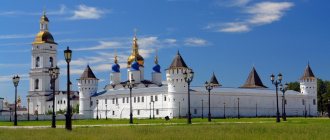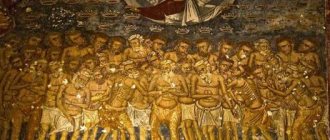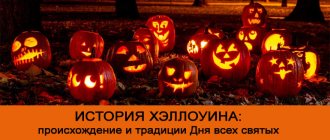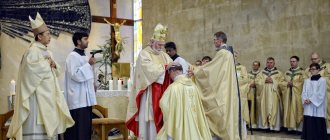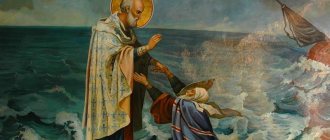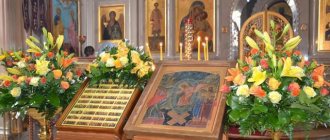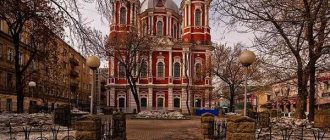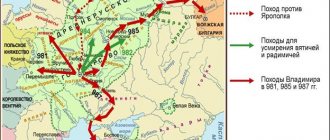There are many famous saints on Russian soil. They were canonized by the Russian Church as martyrs, passion-bearers, saints, righteous people, holy fools, saints, and so on.
These people suffered in the name of Christ. We should not forget about their great feats that they did for our Russian land.
“...Rus' is holy, because holiness is its enduring ideal, because the most fallen person in Rus' knows that “there is a country where truth lives,” and that anyone, even the last sinner in Rus', can enter this country return…"
Andrey Gorbachev
Orthodox author
Icon of the saints of the Russian land. Photo: blogs.pravkamchatka.ru
Sergius of Radonezh - one of the famous defenders of the Russian people
Sergius of Radonezh is one of the famous defenders of the Russian people. The Monk Sergius was born on May 3, 1314 in the village of Varnitsa. At his baptism he received the name Bartholomew. At the age of seven the boy was sent to study, but his education was very difficult.
From the age of 12, the boy fasted and prayed. In 1328, he and his family left for Radonezh. After Sergius's parents died, he and his brother went to more deserted places. Together with him they built a small church of the Holy Trinity.
Venerable Sergius of Radonezh
In 1337, Bartholomew took monastic vows with the name Sergius. After which disciples began to come to him, and a monastery was formed in that place. Sergius of Radonezh became the second abbot and presbyter of the monastery.
A few years later, one of the thriving temples was formed on this site. One day, Patriarch Philotheus learned that Sergius founded the monastery, and decided to pay tribute to his activities. Even then, Sergius was a very famous person in princely circles.
Its significance was very enormous. He blessed many rulers before battles, tried on many people warring among themselves. It is also worth noting that Sergius founded other monasteries, such as Borisoglebovsky, Blagoveshchensky, Georgievsky and others.
The Monk Sergius of Radonezh died on September 25, 1392.
In 1452, Sergius of Radonezh was canonized. The primary source for the description of the life of Sergius of Radonezh was Epiphanius the Wise. He described that Sergius performed many miracles throughout his life.
He healed the sick and lame. One day he resurrected a man. Saint's Memorial Day in the Russian Orthodox Church is September 25.
Who is canonized in Russia
Among the new saints who are now revered by the Orthodox, not only Nicholas II and members of the royal family, there are also exotic characters: in one place a mother declares her deceased child a saint, in another an unrecognized community insists on the holiness of “the martyr Ataulf of Munich,” the more famous like Adolf Hitler. On the Internet you can find icons of Ivan the Terrible, Grigory Rasputin and Joseph the Great (Stalin). The creation of such cults is opposed by the church, which is called upon not only to protect the traditions coming from the first Christian communities, but to separate them from absurdity.
ALEXANDER KRAVETSKY
Finding the rules
People of the older generation probably remember how the authors of Soviet anti-religious pamphlets loved to retell the lives of saints, extracting from them fantastic stories that contradict common sense.
Indeed, in the lives of saints there are plots that contradict historical facts and common sense. Strictly speaking, there is nothing wrong with this. Who even said that what is told in the lives of people should be clearly correlated with a specific time and a specific place? Lives are not historical chronicles. They talk about holiness, and not about the events of human life. This is precisely why hagiography (that is, a description of holiness) differs from biography (a description of life).
To understand why there are so many different oddities in the stories about the lives of saints, you will have to start from afar.
The practice of honoring martyrs and saints is a tradition dating back to the first centuries of Christianity. As long as the Christian church was an association of small communities, there was no particular need to come up with any formal criteria by which saints could be distinguished from simply good Christians. But,
when a conglomerate of small communities turned into a complex hierarchical structure, it became necessary to formulate some general rules and compile lists of saints recognized by all communities.
Among the mandatory rules of canonization (church canonization) were such as the presence of popular veneration and recorded miracles that occurred during the life of the ascetic or after his death. However, for martyrs, that is, saints who preferred death to renunciation of faith, these conditions were not mandatory.
The emergence of formal rules and procedures always opens the way to abuse and the tendency, so to speak, to misuse these rules. For example, there is a known case when a certain Hieron, a wealthy farmer from Cappadocia, resisted the imperial envoys who wanted to take him into military service. In the end, the rebel was tried and sentenced to have his hand cut off.
These events had nothing to do with persecution for faith, but in prison Hieron made a will, according to which his sister was to commemorate him in church as a martyr. And he bequeathed his severed hand to one of the monasteries. The inheritance of the vain farmer was not spent in vain, and hagiographic literature was enriched with the curious “Martyrdom of Jerome and his retinue.” True, this and similar lives still did not become widespread.
Rationalization
After Ancient Rus' adopted Christianity, church-wide norms for the veneration of saints also came here. But there was no strictly organized canonization procedure in Rus' for a very long time. Veneration could begin spontaneously, or could, to some extent, be inspired by power. Some of the ascetics were forgotten, and the cult disappeared, but others continued to be remembered. In the middle of the 16th century, lists of saints were approved and were revered throughout the country.
Metropolitan from the Revolution
But in the 18th century they suddenly began to struggle with the appearance of new saints. The fact is that Peter I firmly believed that it was possible to build life in Russia on rational grounds. Therefore, the emperor was suspicious of stories about all kinds of miracle workers, holy fools and other characters, and considered them deceivers and charlatans.
Petrine legislation directly required that bishops fight superstitions and monitor “whether anyone shows false miracles at icons, treasure chests, springs, etc., for the sake of evil.” Everyone who was involved in governing the state knew that Peter distrusted miracles.
As a result, the Russian Church entered a period of peculiar rationalism, when the hierarchs were most afraid of being deceived and allowing something contrary to common sense into church life. And since the behavior of saints (whether it be a holy fool who violates the rules of public morality or a martyr who violates state laws) cannot in any way be called rational, canonizations in Russia have practically ceased.
Although numerous petitions were sent from the localities to St. Petersburg with a request to canonize various ascetics. However, the Synod most often responded that the petition was not sufficiently substantiated. If the procedure for preparing canonization was started, it turned out to be so long and complicated that there was no chance of completing it. For example,
The Synod required that witnesses to miracles give their testimony under oath, like witnesses speaking at court hearings.
Cases of miraculous healings were verified by doctors, whose testimony was prepared in the same way as the testimony of forensic experts.
The stressed rationality of the Synod was opposed by the way of life of the people. The people's faith was anything but rational. Folklore traditions were combined here with ideas that came from Byzantium along with Christianity, and church sermons were supplemented by stories from all kinds of wanderers. Pilgrims went to the graves of local ascetics, beggars, and holy fools.
Sometimes veneration arose after the accidental discovery of unknown remains. All this contradicted the religious policy of the state, but nothing could be done. The country was too big. The central authorities had no physical opportunity to notice that pilgrims suddenly flocked to some remote village and the grave of an unknown beggar became the center of religious life.
Take off by God's grace
The bishop, whose duties included preventing local amateur activity, could either turn a blind eye to this, or even unofficially support the new pious tradition. Gradually, the necessary liturgical texts arose: someone wrote an akathist, someone wrote a service.
There was a lot of such, so to speak, “unofficial” holiness in Russia. And in the era of Nicholas II, there was suddenly a certain turn towards its legalization. At the beginning of the 20th century, the Synod sent out a questionnaire to bishops asking which saints were venerated in their dioceses. Based on this survey, a book was prepared with a long title: “The Faithful Monthly Book of All Russian Saints, Honored with Prayers and Solemn Liturgies in the Church and Locally, Compiled Based on Reports to the Most Holy Synod of the Most Reverends of All Dioceses in 1901–1902.”
For Russia this was a completely unprecedented experience. Contrary to all domestic traditions, the authorities did not prescribe to their silent subjects who should pray and who should not, but decided to understand what was happening and legitimize existing practices.
Rehabilitation of irrationality
The revolution mixed the cards and destroyed the opposition between popular and official Orthodoxy. This was due to the Bolsheviks' claims that their state was being built on rational principles and a scientific basis. For our topic, it is not so important to what extent the Bolshevik utopia can be considered rational. The very fact of relying on rationality is significant. At the same time, everything connected with church life and, more broadly, with idealistic philosophy was declared reactionary obscurantism. The reaction to the declarative rationalism of the Bolsheviks was that educated Orthodox Christians began to be much more tolerant of the irrational.
The Bolshevik campaign to open the cancer with the remains of saints was supposed to undermine the people's faith in the relics, but it often turned out the other way around. In the photo - the autopsy of Alexander Nevsky's crayfish in 1922
Photo: Karl Bulla / RIA Novosti
These changes first became apparent during the 1919 Bolshevik campaign to uncover the relics. While state propaganda talked about how dummies were found in tombs instead of incorruptible relics, believers—peasants, townspeople, and professors—passed on from mouth to mouth stories that the body of the right-believing Prince Gleb, who died in 1175, Andrei Bogolyubsky) was soft and flexible and the skin on it could be grabbed with your fingers, it would come off like a living thing. And Grand Duke George’s head, cut off in 1238 in a battle with the Tatars, turned out to be fused to the body in such a way that the cervical vertebrae were displaced and fused incorrectly.
If previously a significant part of intelligent believers had a rather cool attitude towards miracles, now everything has changed.
The persecutors were identified with rationality, and the members of the persecuted church rejected rationalism. Miracles have become an essential part of church life. Stories about them helped persecuted communities to endure and survive.
In the 1920s, believers talked about the renewal, that is, the miraculous spontaneous restoration of old blackened icons. Information about this even found its way into reports on the situation in the country that punitive authorities prepared for the top officials of the state.
In the summary of the GPU dating back to 1924, one can read that the counter-revolutionary clergy “made every effort to incite religious fanaticism by falsifying all kinds of miracles, such as: the appearance of saints, miraculous icons, wells, the mass renewal of icons that swept throughout the USSR, etc. d.; the latter, that is, the renewal of icons, was of an epidemic nature and even captured the Leningrad province, where up to 100 cases of renewal were registered in the month of October.”
The very fact that this information was included in the summary of the most important events that took place in the country indicates the scale of the phenomenon. But this example is not isolated.
“The renewal of icons and rumors about miraculous relics,” we read in a similar report for 1925, “are spreading in a wide wave; Over the past month, more than 1,000 cases have been registered in the Ivanovo-Voznesensk, Bryansk, Orenburg, Ural, Ulyanovsk provinces and the Far East.”
I quite deliberately cite here not the stories of believers, but the testimonies of punitive authorities, who saw only deception in all these miracles. It is difficult to suspect employees of the GPU of defending miracles, which means it is impossible to doubt their evidence.
During the Soviet years, at least three generations of people grew up who were not taught the basics of the Orthodox faith. Their ideas about what church doctrine was were based on some kind of semi-folklore tradition. And it is not surprising that they associated Orthodoxy not so much with the Gospel narrative, but with miracles, wanderers, holy fools and found icons. Half-forgotten ascetics, who were partially remembered in distant villages, now aroused not rejection, but great interest. The massive inclusion of new names in the church calendar was a matter of time.
At the end of the 70s, the Moscow Patriarchate began publishing a new edition of the Menaion, books containing services for every day of the church year. The 24 voluminous volumes included a huge number of services to saints that had not previously been mentioned in liturgical books. What previously existed in a semi-underground regime has now become a general church norm.
New Martyrs and Confessors
With the beginning of perestroika, it became possible to begin the canonization of new martyrs killed under Soviet rule.
In 1989, the Moscow Patriarchate canonized Patriarch Tikhon, and five years later priests Ivan Kochurov (killed by the Bolsheviks in October 1917) and Alexander Khotovitsky (executed in 1937) were canonized.
The first of those who suffered in the 20th century at the hands of the Bolsheviks was canonized Patriarch Tikhon, elected to the patriarchal throne in 1917
Photo: MAMM/MDF
Then it seemed that the canonization of victims of communist persecution was opening a new stage in church history. But very soon it became clear that most believers were not interested in the history of persecution and repression.
I remember my shock when, about two years after the canonization of Alexander Khotovitsky, at the request of my Finnish colleagues, I went to the Moscow church of which Father Alexander was rector in the last years of his life. I wanted to find out if there were any old parishioners left here who could tell something about him. I came during off-duty hours and turned to the man standing behind the candle box with the question of whether there were any people left here who could remember their recently canonized abbot.
“Alexander Khotovitsky...” My interlocutor thought for a moment. “I’ve been working here for 15 years, but this definitely hasn’t happened.” That is, the temple employee had no idea that half a century ago the rector of this temple was a saint who had just been canonized.
In subsequent years, work on preparing materials for canonization was very active. And there were more than enough problems here. Where can I get reliable information about people who died for their faith? It is clear that the main source here is investigative cases. Based on the interrogation protocols, it can be established that the person did not renounce his faith, did not betray or slander anyone. But it is known that what is written in the protocols does not always accurately reflect what happened during the investigation. Testimony could be falsified, signatures could be forged, etc.
What to do, for example, if an elderly priest from a remote Tula village did not renounce, did not betray, but signed a confession that he is a Japanese spy? Is this an obstacle to canonization?
Despite all the difficulties, it was possible to collect materials and canonize about 2 thousand people who suffered during the years of Soviet power. Of course, this is a drop in the ocean, but it has now become impossible to continue this work. In 2006, a law on personal data was passed, which effectively blocked researchers' access to investigative files. As a result, the preparation of materials for new canonizations ceased.
According to mothers
The Church must always draw a line between holiness and occult practices, and also monitor the reliability of the information on the basis of which sainthood is canonized. Therefore, in all eras there were rather strange local cults that were not recognized by the church authorities.
For example, in our time, pilgrims from all over the country go to the village of Chebarkul (Chelyabinsk region), where 11-year-old Vyacheslav Krasheninnikov, who died of leukemia, is buried. The boy's mother considers her son a saint and works with inspiration to create his cult. According to his mother, several books were written dedicated to the miracles and predictions of Vyacheslav. Naturally, predictions about the end of the world are the most popular.
Valentina Krasheninnikova considers her son Vyacheslav, who died at the age of 11, to be a saint and was able to convince many people of this
They look something like this: “Fallen angels (grays, Atlanteans) are engaged on Earth in servicing a program installed in the core of the planet to collect human souls, and the Antichrist represents their interests among people, connecting every person to it through a seal (biochip).
Fallen angels are destroying people, the Antichrist is helping them, and the world serving government is running around at their beck and call.”
Pilgrims talk about healings and bring earth and marble chips from the grave of the youth Vyacheslav. At the same time, of course, there is no talk of the official canonization of Vyacheslav Krasheninnikov.
The Chairman of the Canonization Commission, Metropolitan Yuvenaly, spoke very harshly about this cult: “Descriptions of strange and absurd “miracles” and “prophecies”, overflowing with content harmful to the soul, almost magical rituals at the burial site of this child, non-canonical icons and akathists - all this forms the basis activities of followers of the Chebarkul false saint."
However, the official church position in no way influenced the veneration of the youth Vyacheslav, and pilgrimages to him continue.
Another “unrecognized saint” is the warrior Eugene. We also owe the beginning of the veneration of Yevgeny Rodionov, who was killed in Chechnya in May 1996, to his mother. Private Rodionov and his partner Andrei Trusov were captured when they tried to inspect the car in which the weapons were transported. The initial version of the disappearance of the soldiers was desertion, but later it became clear that they had been kidnapped.
Rodionov's mother went in search of her son. After overcoming a lot of difficulties and paying the militants, she learned the details of her son’s death and found his burial place. According to the mother, she was given a meeting with Evgeniy’s killer. The killer said that the young man was offered to remove the cross and change his faith, but he refused, for which he was killed.
If it could be proven that private Yevgeny Rodionov really refused to remove the cross, for which he was killed, this could serve as a basis for canonizing him.
According to ancient rules, a situation where a person dies, refusing to change his faith, is an indisputable basis for canonization. But the Canonization Commission refused to canonize Yevgeny Rodionov, since the only evidence of his feat is the story of his mother.
However, admirers of Yevgeny Rodionov are not going to give up. They create all kinds of petitions and collect signatures. For example, in 2016, at a round table meeting of the Izborsk Club, a letter was signed to Patriarch Kirill with a request to begin preparations for this canonization.
There are quite a few stories about such unrecognized saints (or pseudo-saints, if you like). The emergence of these cults is not unusual, and has happened many times throughout church history. The only thing that is new is the way of disseminating information.
Never before have the pious legends and dubious myths born of popular religiosity received such a huge audience as is provided by modern means of electronic communication.
Invasion of politics
In 2000, among other new martyrs, Nicholas II and members of his family were canonized. Members of the royal family were canonized not as martyrs (martyrs accept death for Christ, which was not the case in this case), but as passion-bearers. The passion-bearers suffered martyrdom not from persecutors of Christians, but as a result of betrayal or conspiracy. Princes Boris and Gleb, for example, were canonized as passion-bearers.
Iconographic images of the royal family can often be seen on posters and banners during various patriotic processions
Photo: Alexander Petrosyan, Kommersant
The wording of the canonization act was very careful and careful. This caution is understandable. The fact is that in the Russian Church there was and still exists a movement whose adherents attach a very special meaning to the murder of the last emperor.
According to the Tsarebozhniki (as representatives of this movement are usually called), the monarchy is the only Christian form of government and any anti-monarchical protests are not so much political as spiritual in nature. In their opinion, in 1613 the Russian people made their choice by swearing allegiance to the Romanovs. The Tsarebozhniks perceive the entire subsequent history of Russia as a series of betrayals and deviations from monarchical ideas.
And in the death of Nicholas II they see not a political murder, but a mystical act of atonement: similarly
just as Christ atoned for original sin with his sacrifice, the last emperor with his death atoned for the guilt of the Russian people before the legitimate, God-given royal power.
Therefore, according to the Tsar-worshipers, the Moscow Patriarchate was wrong in calling Nicholas II a passion-bearer: he is not a passion-bearer, but a Tsar-Redeemer. Adherents of this movement are few in number, but very active and often find themselves in public space. A number of inadequate speeches regarding the film “Matilda” were associated precisely with this ideology.
The desire to protect the name of Nicholas II from everything that could discredit him naturally led to the idea that Grigory Rasputin was a righteous man, and all the dirt associated with his name is slander of the enemies of the monarchy and the invention of the “Jewish press.” Thus, a movement began for the canonization of “Elder Gregory.”
After this, it no longer seems surprising that, along with Rasputin, Ivan the Terrible was also a candidate for canonization. According to admirers of Ivan IV, he held Russia in the face of impending chaos, for which he was slandered by Russia's enemies.
Church authorities immediately reacted sharply to these proposals. In 2001, Patriarch Alexy II publicly condemned the distribution of icons and prayers to Ivan the Terrible and Grigory Rasputin. “Some group of pseudo-zealots of Orthodoxy and autocracy,” said the patriarch, “is trying to arbitrarily “through the back door” to canonize tyrants and adventurers, to accustom people of little faith to their veneration.”
Rasputin’s admirers were not particularly impressed that Patriarch Alexy II publicly condemned the distribution of icons of “Elder Gregory”
Photo: www.ic-xc-nika.ru
It must be said that Rasputin and Ivan the Terrible are not yet the most exotic candidates for the role of saints.
In 2000, one of the church groups opposed to the Moscow Patriarchate canonized Ataulf of Munich, better known as Adolf Hitler. In some way, the interest in Hitler on the part of religious groups that deny the Moscow Patriarchate is justified. As is known, Hitler’s anti-communist declarations aroused the support of some Russian emigrants. The Russian Church Abroad also supported Hitler, hoping that he would save Russia from communism.
The head of the German diocese of the Russian Church Abroad, Archbishop Seraphim (Lyade), in an appeal to the flock issued in connection with the German attack on the USSR, wrote: “The Christ-loving leader of the German people called on his victorious army to a new fight against the God-fighters, to the fight that we have long been waiting for , - to the sanctified struggle against the atheists, executioners and rapists entrenched in the Moscow Kremlin... Truly, a new crusade has begun in the name of saving peoples from the power of the Antichrist.”
For some, sobering came quickly, for others slowly. It is clear that after the end of World War II and the Nuremberg trials, such declarations were no longer possible.
After the fall of the USSR, in the wake of rejection of communist ideology, they remembered Hitler. The leader of one of the unrecognized church groups, Ambrose (von Sievers), began to call for his canonization. In 2000, the group's official journal wrote:
“The Catacomb Church has always confessed and now confesses that Hitler, for true Orthodox Christians, is God’s chosen anointed leader, not only in the political, but also in the spiritual and mystical sense, the good fruits of whose deeds are still palpable today. Therefore, true Orthodox Christians, of course, give him some honor as a kind of “external righteous man” who remained outside the Church for his attempt to liberate the Russian land from the Jewish-Bolshevik invasion.” Some time later, even an icon of Ataulf of Munich was painted.
Looking at the icon of Ataulf of Munich, it is difficult to believe that this is not a parody or an avant-garde action created to shock the audience
In marginal patriotic journalism one can find calls to canonize Stalin. Supporters of this canonization believe that the mass destruction of churches and clergy during his reign was a kind of pedagogical technique with the help of which “God-loving Joseph” educated the Russian people, mired in sins.
And according to another version, supporters of Lenin and Trotsky, whom Joseph the Great dealt with during the Great Terror, were to blame for the anti-church campaign. There are home-grown icons of Stalin and prayers to him.
On the icon of the Matrona of Moscow, Stalin was depicted at least without a halo
Photo: Interpress / TASS
All this marginal creativity once again demonstrates to us the monstrous results that attempts to give political declarations the character of church teachings lead to.
Among the saints of Russian Orthodoxy, Seraphim of Sarov is also famous
Among the saints of Russian Orthodoxy, Seraphim of Sarov is also famous. His name in the world was Prokhor, and he was born on July 19, 1759. Since he had an excellent memory, Prokhor learned to read and write early.
From early childhood he visited the temple and prayed. At the age of 20, he decided to go to the Sarov Hermitage. In 1786, the saint was tonsured into monasticism by the abbot of the monastery.
Icon of Seraphim of Sarov. Photo: hranitel.club
He was also later ordained a hieromonk. But for himself, he decided to choose the path of solitude. He went to the forest to labor there, in strict fasting and prayer. During all the years of his life in seclusion, he was filled with love for God, and he also developed a special love for people.
During his lifetime, the Lord honored Seraphim of Sarov with grace-filled gifts, such as insight, consolation, healing of souls and bodies. One day the Mother of God appeared to him and told him to come out of seclusion and receive people with her.
Seraphim had the gift of insight; he saw what would happen to Russia before the end of its century.
This is what the saint did.
On January 1, 1833, the saint attended the liturgy for the last time, took communion and departed peacefully to the Lord. His glorification took place in 1903.
Holy Princes Boris and Gleb - glorified saints of the Russian land
Holy princes Boris and Gleb are renowned saints of the Russian land. Prince Vladimir was their father, he is also a famous person not only in history, but in Orthodoxy.
It was under him that the Baptism of Rus' took place, that is, one of the significant events for the Russian Church. The well-known Princess Olga, the first Russian saint, was his grandmother.
Saints of the Russian land, princes Boris and Gleb. Photo: 4.404content.com
Shortly before the Baptism of Rus' took place, princes Boris and Gleb were raised in Christian piety and purity. Saint Prince Boris received a very good education and loved to read the Holy Scriptures.
It was under the influence of the saints that Boris had an ardent desire to imitate each of the saints of God. Saint Gleb did not share the views of his brother. But both brothers were distinguished by their mercy and kindness of heart. They wanted to imitate their father, Equal-to-the-Apostles Prince Vladimir, in everything.
When Vladimir died, the Pechenegs attacked Rus'.
Saint Boris was chosen as the leader. One day Boris found out that Prince Svyatopolk wanted him dead, and he did not resist. Boris prayed and began to await his fate. This is how Saint Boris died. Boris and Gleb were the first Russian saints.
Next, Svyatopolk moved towards Gleb. Gleb accepted his brother’s death as befitted an Orthodox Christian. Thus, Gleb was killed by his own cook, who was persuaded to do this. Both saints were canonized by the Russian Orthodox Church
Metropolitan Alexy of Moscow and All Rus' became one of the famous saints of the Russian land
Metropolitan Alexy of Moscow and All Rus' became one of the famous saints of the Russian land. He was born at the turn of the 18th - 19th centuries. Saint Alexy came from a noble family of Chernigov boyars, the Kolychevs.
At baptism he received the name Eleutherius. His successor was Prince Righteous John, the future Grand Duke of Moscow. It was John who was later nicknamed John Kalita.
Icon of St. Alexis, Metropolitan of Moscow and All Rus'. Photo: molitvoslov.today
Already in adolescence, the Lord revealed to St. Alexis his destiny. He loved to catch birds with nets, but one day, when he was dozing off, in his dream he heard a voice that told him that he was wasting his time. When the boy woke up, he realized that no one was around. But he heard the voice too clearly.
In 1320, Eleutherius decided to take monastic vows. For 20 years he performed monastic obediences under the leadership of Elder Gerontius. In the monastery he studied Greek and read spiritual literature.
In 1350, Eleutherius was ordained bishop.
At that time, everyone turned to him for wise advice not only in church matters, but also in civil matters.
Once he healed the blind wife of one khan. The Khan granted him a plot of land on which Alexy built the Chudov Monastery. It is also worth noting that Alexy was not afraid to go to the Horde, in which death could possibly await him.
Throughout his life, Alexy cared about the improvement of his Russian flock and its spiritual enlightenment. In Moscow, he restored former monasteries and built new ones. Saint Alexy died in 1378.
1378
Saint Alexy died this year
He was buried in the Chudov Monastery. About 50 years later, his relics were found and found incorrupt. His glorification as a saint took place in 1431.
Dmitry Donskoy canonized by the Russian Orthodox Church
Another of the famous saints of the Russian land is Dmitry Donskoy. Born on October 12, 1350 in Moscow. When his father died, Metropolitan Alexy became his mentor and guardian. Dmitry also developed a very good relationship with St. Sergius of Radonezh. It was to him before the battle that Dmitry came.
Icon of Saint Prince Dmitry Donskoy. Photo: cs5.livemaster.ru
For a very long time the prince was at enmity with different peoples, but after 9 years peace was concluded. Gradually he established relationships with everyone. Since he was a believer, he constantly supported churches and monasteries.
In 1380, one of the great battles of Kulikovo took place, during which Mamaia was defeated.
1380
this year the Battle of Kulikovo took place
Dmitry Donskoy died quite early, at 39 years old. He was buried in the Archangel Cathedral in Moscow. He was canonized by the Russian Orthodox Church. His memorial day is May 19.
Venerable Anthony and Theodosius of Pechersk
The saints about whom I would like to say especially are the Monks Anthony and Theodosius of Pechersk. They are the “chiefs” of ascetic life in Rus'. Thus, the Monk Anthony, having become the first Russian monk, brought the monastic Rule from Holy Mount Athos, where he labored for a very long time. The Monk Theodosius is the founder of a more organized, so to speak, cenobitic monasticism in Rus'. It was he who founded the very first monastery in our lands (now the great Holy Dormition Lavra), from which monasticism spread throughout Rus' and which became a model for a huge number of monastic communities.
Princess Olga became the first saint on Russian soil
Let's talk separately about Princess Olga, who was discussed a little higher. Princess Olga became the first saint. After her husband was killed, she took over the rule of Kievan Rus.
Princess Olga became the first Russian saint
Throughout her life, she walked across Russian lands to build the economic and political life of Kievan Rus. She built temples and churches. It was during her reign that Rus' greatly strengthened and grew.
New cities began to appear. It is also worth noting that she spread the Christian faith. Temples appeared on Slavic soil under her. Olga wanted to involve her son Svyatoslav in this, but he did not listen to his mother and remained a pagan until the end of his days.
In 969, Princess Olga died. She was later canonized. Every year she is venerated in the Russian Orthodox Church on July 24.
These are just a few of the saints of the Russian land who were and remain defenders of our Russia.
By leaving a comment, you accept the user agreement
Equal to the Apostles Prince Vladimir
The future enlightener of Rus' was the son of Grand Duke Svyatoslav Igorevich, and his mother (Princess Malusha), although she came from a Varangian family, professed the Christian faith. Young Vladimir was given the reign of Novgorod, where he grew up under the supervision of his uncle Dobrynya, a rude pagan. Soon, as a result of internecine wars, Vladimir reigned in Kyiv. Having established himself in the glorious city with the aim of better centralizing power and consolidating the Slavic tribes, he decides to establish unity of faith in Rus' and in the course of a long search (Vladimir himself talked about faith with representatives of various religions who were at the princely court, and repeatedly sent his proxies to see , so to speak, “faith on the ground”) is inclined to accept Christianity. Having accepted his own baptism, the holy prince subsequently called on his boyars to accept Christianity, as a result of which in 988, in the waters of the Pochayna River (a tributary of the Dnieper), the Sacrament of Baptism was performed on the ancient people of Kiev.
